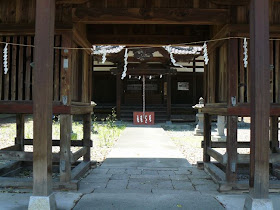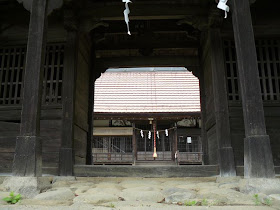Previous posts in this series:
- Heijūmon
- Kabukimon
- Kōraimon
- Yakuimon
- Yotsu-ashimon
- Munamon
- Commentary
- Uzumimon
- Yaguramon
- Rōmon
- Shōrōmon
- Taikomon
- Nijūmon
- Sanmon
- Niōmon
- Nitenmon
- Sōmon
- Wakimon
- Chokushimon
- Onarimon
Tansōmon (単層門)
The word tansō (単層) refers to such things as geological strata, layers, laminae, and, by extension, social class. A tansōmon is a layer of sorts too: it is an eight-legged gate (hyakkyaku-mon) which lacks a second story altogether - it is but a simple, single layer version of the eight-legged gate. This form of gate associates primarily with shrines, not temples. Ordinary shines are called jinja (神社).
Let's start with an example from Ehara Sengen Jinja (江原浅間神社) in Yamagata Prefecture:
No niō to be found here:
Umi Jinja (宇美神社) in Niigata Prefecture:
Next, in Yamanashi City, Yamanashi Prefecture, there is Nakamaki Jinja (中牧神社):
A peek through the gate to see the honden, or main shrine building:
Time for some color! Kandaten Jinja (菅田天神社) in Kōshō City (甲州市) - also located in Yamanashi Prefecture, and erected in 842:
Nice examples of the tasoya type of shrine lantern, with the more complex type of window lattice involving radiating verticals.
And a view looking through the opening of the gate to the precinct beyond:
Since these gates appear at shrines, it it not uncommon to see them decorated with a large braided straw rope, or shimenawa. Here's the tansōmon at Igata-ke Jinja (伊賀多気神社) in Shimane Prefecture:
A shimenawa also graces the entry of the honden:
All for today - I could show many more examples of this gate, however the form is fairly consistent from gate to gate so there seems like little point in simply showing more examples. This series continues - thanks for coming by the Carpentry Way. On to post 22









Hello Chris,
ReplyDeleteGreat series,have enjoyed finding out about all the different gates and their significances. To think that some of these gates were first built in 842[presumably there are older examples?] is just mind-boggling,it's no wonder the Japanese are so far ahead in wood crafting. This last post mentions the shrine gates and how sometimes braided rope is hung there.Pardon my ignorance but is there a significance to this?
Looking forward to the rest of the series,
Regards,David
David,
Deletethanks for the comment, and glad to hear you are enjoying this series.
As for the shimenawa is concerned, you will notice that where the word is first written in text above, that it is in bold font, and slightly blue. That makes it a link - click on that link and you will learn more about shimenawa on another web page.
Most anytime you see text on this blog with a different color, or in bold, that means it is a link.
Cheers,
~C